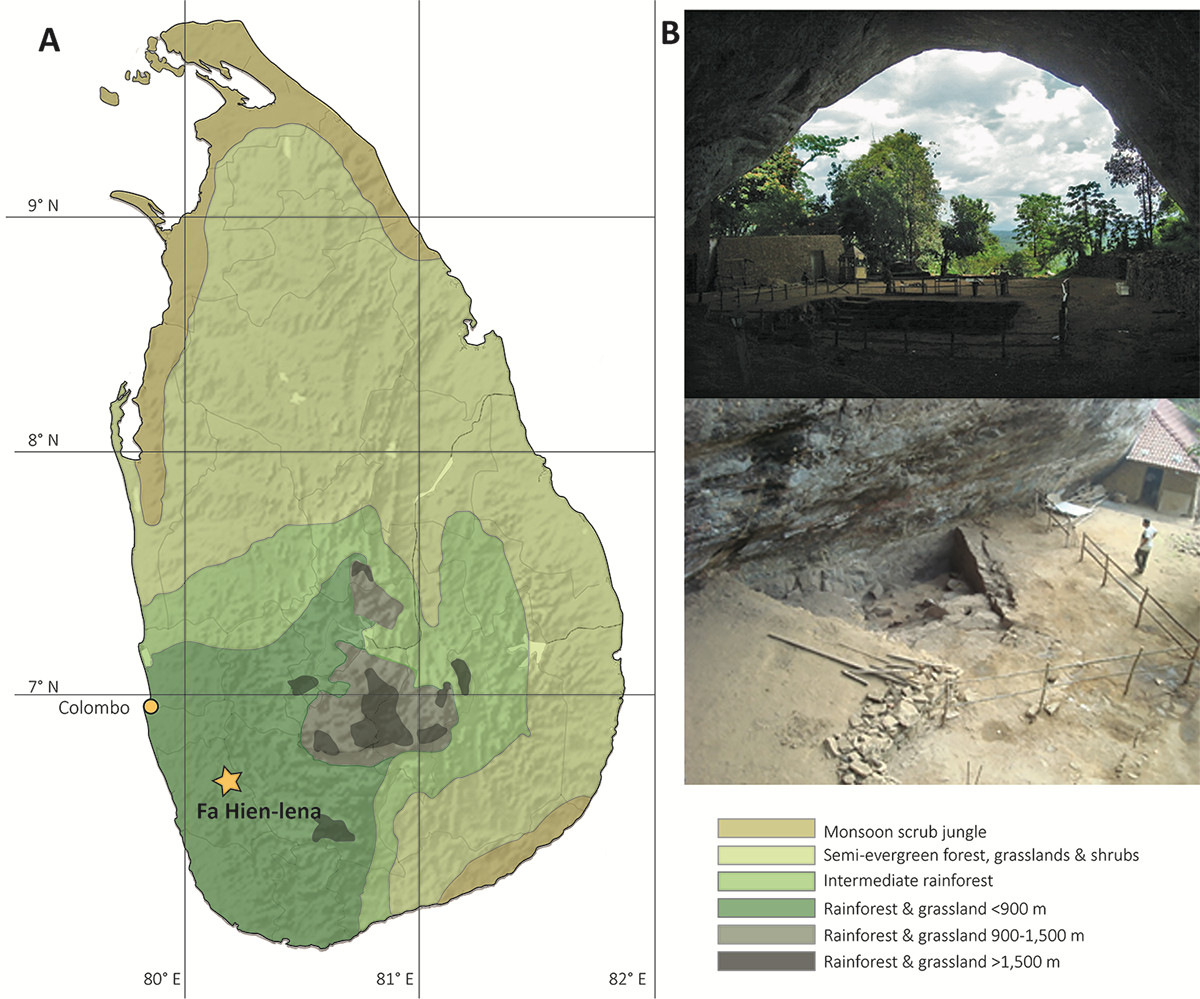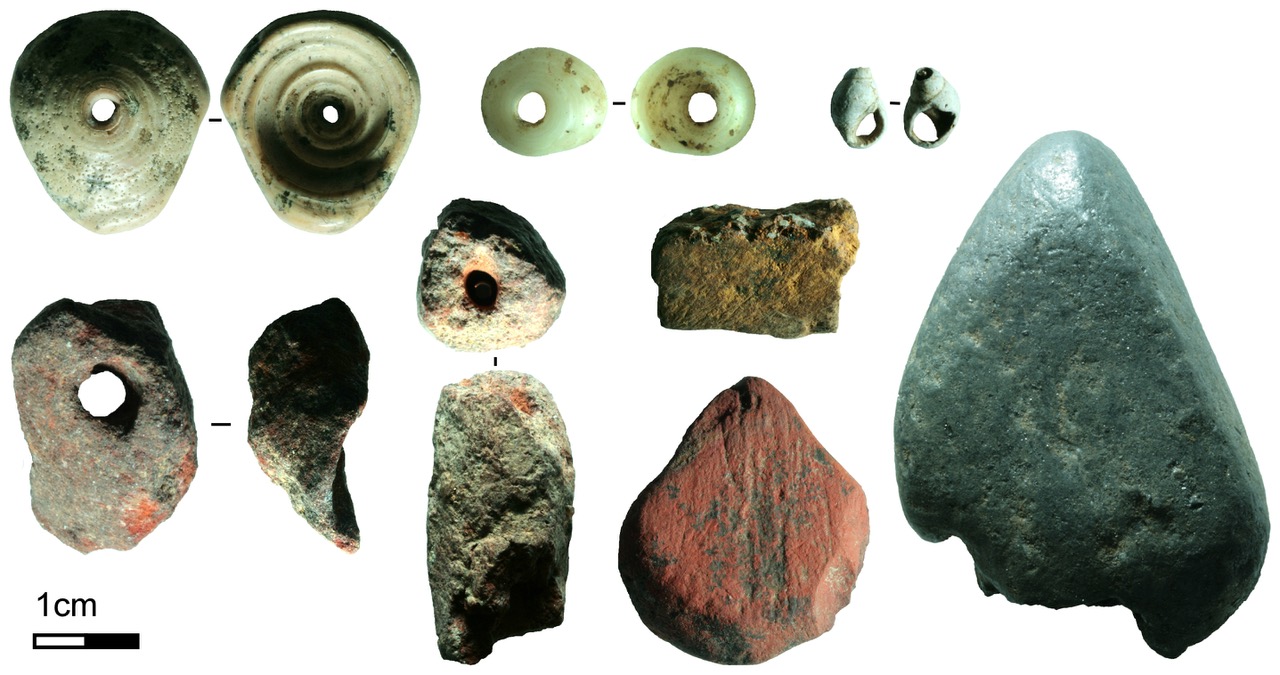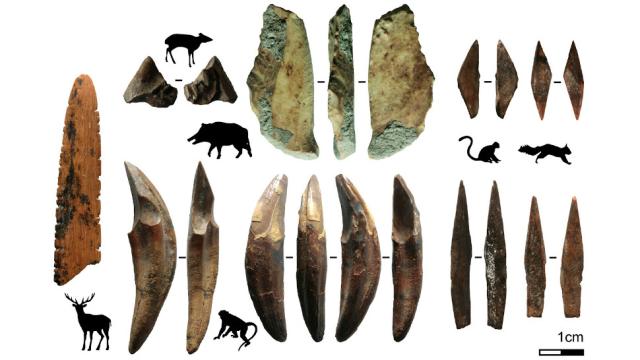Ancient bow-and-arrow technology dating back some 48,000 years has been discovered in a Sri Lankan cave, making it the oldest evidence of archery to be found in this part of the world.
Ornamental beads, tools to fashion clothes, and projectile points for bows and arrows have been unearthed at Fa-Hien Lena, a cave in southwest Sri Lanka. At a maximum age of 48,000 years old, this evidence for bow and arrow technology is the oldest ever found in South Asia, and possibly across all of Eurasia. This research was published on Friday in Science Advances.
“This new archaeological evidence from Fa-Hien Lena cave in Sri Lanka provides an important reminder that modern human behaviour has deep roots in areas far from our African homeland, at a comparable or perhaps even greater age than the better-known evidence from Europe,” Chris Stringer, an archaeologist from the Natural History Museum of London who wasn’t involved in the new study, told Gizmodo in an email.
It’s reasonably well established that early modern humans were living in South Asia during the Late Pleistocene, but archaeologists don’t always agree on the exact timing, and investigations into their material culture is sorely lacking. The reason for this, according to an associated press release put out by the Max Planck Institute for the Science of Human History (MPI-SHH), is that the “origins of human innovation have traditionally been sought in the grasslands and coasts of Africa or the temperate environments of Europe.” As for the tropical rainforests of South Asia, not so much.
MPI-SHH archaeologist Patrick Roberts, a co-author of the new study, said in the release that “this traditional focus has meant that other parts of Africa, Asia, Australasia, and the Americas have often been side-lined in discussions of the origins of material culture, such as novel projectile hunting methods or cultural innovations associated with our species.”

Stefano Benazzi, a paleontologist at the University of Bologna who’s not affiliated with the new research, told Gizmodo in an email that the new paper is important because it shows how “the earliest modern humans in Southeast Asia adapted to different environments using diverse a toolkit.”
Working at Fa-Hien Lena, the archaeologists uncovered four distinct phases of occupation at the cave, dating from 48,000 years ago to 4,000 years ago. The bow and arrow projectile points were made from animal bone and assigned a maximum age of 48,000 years old. But a careful reading of the paper shows the stratigraphic layer in which they were found could be as young as 34,000 years old.
In total, the archaeologists uncovered 130 projectile points. Looking at them through a microscope, the scientists saw evidence of prior use in the form of fractures. The points also exhibited notches and wear patterns consistent with having been attached to thin shafts. They were too short and heavy to be used as blow gun darts, leading the team to conclude that the projectile points were associated with bow and arrow technology.
“The ecological setting is quite different from the open environments of African grasslands and the ice age plains of northern Europe,” Stringer told Gizmodo. “The Fa-Hien Lena finds suggest that bone points used as arrowheads were produced there, and used to hunt a range of elusive rainforest prey, such as squirrels and monkeys.”
Interestingly, the length of these points increased over time, which the authors contend is a sign that these hunters eventually transitioned to larger game, such as pigs and deer.
The cave also yielded 29 bone tools used to work animal skins and plant fibres, which these early humans used to fashion clothing or, possibly, nets and traps. Humans living in tropical rainforests don’t really require lots of clothing, but the authors suspect they may have worn it as “a layer of protection from insect-borne disease.”

In addition to these items, the researchers also found decorative beads made from mineral ochre and marine snail shells. These resources could not have been sourced locally, pointing to the presence of an early yet complex, trading network in the tropics.
“The Sri Lankan evidence shows that the invention of bows-and-arrows, clothing, and symbolic signalling [i.e. jewellery] occurred multiple times and in multiple different places, including within the tropical rainforests of Asia,” explained co-author Michael Petraglia of the MPI-SHH.
Archaeologist Israel Hershkovitz from Tel Aviv University, who wasn’t involved in the new research, said the new paper was “interesting,” but he took exception to the opening statement of the MPI-SHH press release, about how the origins of human innovation are typically sought in Africa or Europe. This is “totally incorrect,” he told Gizmodo, saying “many of the great innovations took place in Asia — writing, the wheel, domestication, urban society, monotheism, and so on — a fact that is ignored throughout the paper.”
As to whether or not the bone artifacts found at Fa-Hien Lena were actually arrowheads, that’s “open to interpretation,” said Hershkovitz. “I agree that people are creative everywhere.”
This doesn’t necessarily imply that “the invention of bows and arrows, clothing, symbolic signals, and so on, occurred multiple times and in multiple different places — Sri Lanka included,” Hershkovitz said. “The inhabitants of the island could have brought them from the outside.”
Benazzi was “quite disappointed” to see that the authors, “hopefully not on purpose,” failed to mention a paper he and his colleagues published in Nature last year about the earliest evidence of projectile technology outside of Africa. As this paper pointed out, bow and arrow technologies outside of Africa existed at least 45,000 years ago — an age close to the one claimed in the new paper. And given a possible minimal age of 34,000 years old, the finds at Fa-Hien Lena could be considerably younger than the European examples. Bow and arrow technologies first appeared in Africa some 64,000 years ago.
What’s more, the authors didn’t do any experimental archaeology, in which they would try to replicate the fractures seen in the bone samples, said Benazzi. Despite these criticisms, Benazzi said the authors “published a nice piece of work,” and “some of their final statements were not unexpected, as previous contributions already confirmed that mechanically delivered projectile technologies outside Africa dated back at least 45,000 years ago.”
This research certainly appears to be rough around the edges, but it’s clear that early modern humans were doing extraordinary things long ago in extreme tropical environments. That these technologies emerged spontaneously is a fascinating possibility, and yet another example of necessity being the mother of invention.
Editor’s Note: Release dates within this article are based in the U.S., but will be updated with local Australian dates as soon as we know more.
